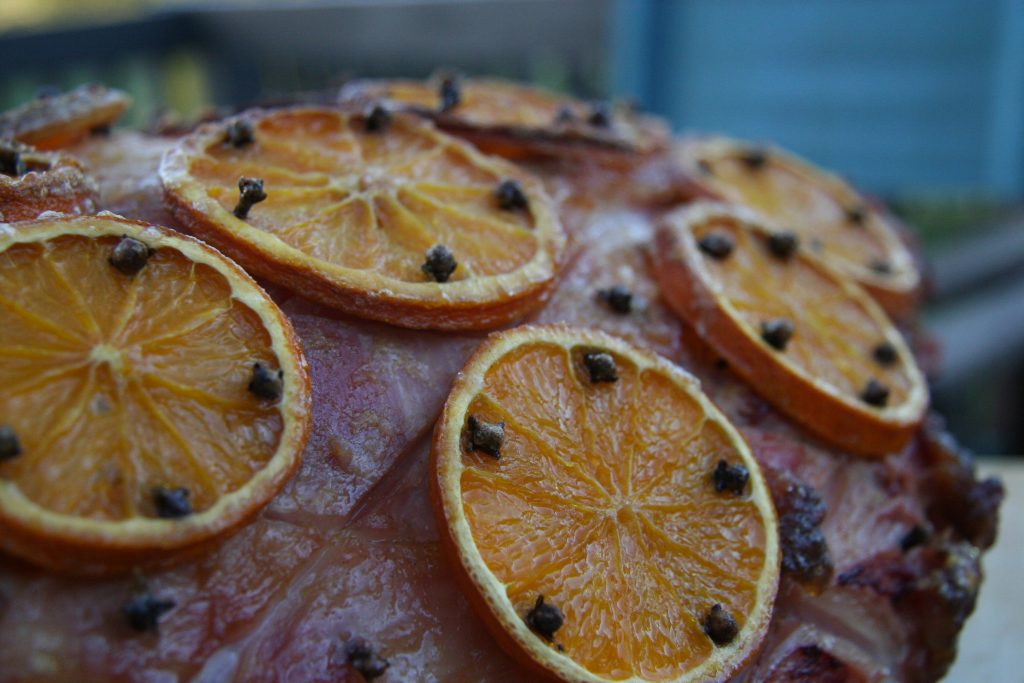Time for our Christmas recipe: Tender Posted by carol on Dec 10, 2019 in Brazilian Profile, Culture, Customs, Holidays, Vocabulary
Saudações a todos os leitores! Greetings to all readers! So it is dezembro (December) already. But before the New Year rolls in, it is time to focus our energies on the main event: A ceia de natal (Christmas dinner). As we have mentioned in other Holidays-related posts, Brazilians are all about véspera de natal (Christmas Eve). This is when we typically celebrate by gathering with friends and family and having an endless feast. But what is on the menu? Well, options abound, but there are some favorites that are not to be missed on our mesa (table) on this special date.
One of them is the adorably named tender. This holiday staple, with its one-of-a-kind look, can be found on the cardápio natalino (Christmas menus) in most lares (households) across the country. Technically, the classic version of this juicy main dish is simply a round piece of glazed smoked presunto (ham) cut into geometrical shapes and adorned with cloves.
But what’s with the name, though? Surprisingly enough, the originally American receita (recipe), was exported to Brazil decades ago followed by an advertisement campaign to promote it. The slogan would read Tender Made, and this is where this beloved meal gets its name from. Would you like to give this traditional sweet-and-sour delight a go? We have the recipe for this all-time hit right here!
O que você vai precisar – What you’ll need
- Uma peça de tender suíno | A piece of smoked pork ham
- Uma cebola fatiada em 4 porções | One onion sliced into 4 portions
- Cinco laranjas | Five oranges
- Cinco colheres de sopa de mel | Five tablespoons of honey
- Duas colheres de sopa de mostarda | Two tablespoons of mustard
- ½ xícara de vinho branco | ½ cup white wine
- Cravos para decorar | Cloves to garnish
Modo de preparo | Steps
- Numa tigela, misture o suco das 5 laranjas, o vinho, o mel e a mostarda. Reserve | In a bowl, combine the orange juice, the wine, the honey and mustard. Set aside.
- Retire o tender da embalagem e lave em água corrente. Seque com papel toalha e faça cortes superficiais na carne, em diagonal, formando losangos | Unpackage the meat and wash under running water. Dry it with paper towels and cut the meat diagonally into diamond shapes.
- Coloque o tender na tigela e besunte ele com o molho de laranja. Deixe marinando por 30 minutos e vire a carne de vez em quando | Place the meat in the bowl and cover it in the orange sauce. Leave to marinade for 30 minutes and turn the meat over from time to time
- Retire da tigela e espete algumas pontas dos losangos com os cravos | Remove from bowl and stick some cloves in between the diamond shapes
- Num tabuleiro, espalhe as cebolas e coloque o tender sobre elas. Despeje o molho e cubra com papel alumínio | On a baking pan, spread the onions and place the meat on top. Pour the sauce and cover with aluminum foil
- Leve ao forno à 180° por 40 minutos. Regue o tender com o molho a cada 15 minutos para deixá-lo úmido e suculento | Bake at 180 ° for 40 minutes. Drizzle with sauce every 15 minutes to make it moist and juicy
- Retire o papel alumínio e deixe dourando por mais 20 minutos. Continue regando a carne | Remove foil and let it brown for another 20 minutes. Keep drizzling the meat
- Quando estiver bem dourado, retire do forno e sirva em seguida. Decore frutas como abacaxi, carambola ou fatias de laranja | When golden, remove from oven and serve. Garnish with fruits such as pineapple, star fruit or orange slices
Looking for um acompanhamento (a side-dish) as well? This salpicão recipe is sure to bring you and your family a Merry Christmas!

Build vocabulary, practice pronunciation, and more with Transparent Language Online. Available anytime, anywhere, on any device.





Comments:
Lindsay:
Maybe next year 🙂